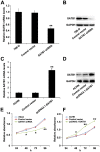Overexpression of SATB1 is associated with biologic behavior in human renal cell carcinoma
- PMID: 24835085
- PMCID: PMC4023980
- DOI: 10.1371/journal.pone.0097406
Overexpression of SATB1 is associated with biologic behavior in human renal cell carcinoma
Retraction in
-
Retraction: Overexpression of SATB1 Is Associated with Biologic Behavior in Human Renal Cell Carcinoma.PLoS One. 2024 Apr 2;19(4):e0301571. doi: 10.1371/journal.pone.0301571. eCollection 2024. PLoS One. 2024. PMID: 38564511 Free PMC article. No abstract available.
Abstract
Special AT-rich sequence-binding protein-1 (SATB1) has been reported to be aberrantly expressed in various cancers and correlated with the malignant behavior of cancer cells. However, the function of SATB1 in RCC remains unclear. With the combination of immunohistochemistry, western blotting, immunofluorescence, qRT-PCR, and cell proliferation, migration and invasion assays, we found that levels of SATB1 mRNA and protein were dramatically increased in human ccRCC tissues (P<0.001 for both), and upregulation of SATB1 was significantly associated with depth of invasion (P<0.001), lymph node status (P = 0.001) and TNM stage (P = 0.009). SATB1 knockdown inhibited the proliferation, migration and invasion of 786-O cells, whereas SATB1 overexpression promoted the growth and aggressive phenotype of ACHN cells in vitro. Furthermore, SATB1 expression was positively correlated with ZEB2 expression (P = 0.013), and inversely linked to levels of SATB2 and E-cadherin (P = 0.005 and P<0.001, respectively) in ccRCC tissues. Our data provide a basis for the concept that overexpression of SATB1 may play a critical role in the acquisition of an aggressive phenotype for RCC cells through EMT, providing new insights into the significance of SATB1 in invasion and metastasis of ccRCC, which may contribute to fully elucidating the exact mechanism of development and progression of RCC.
Conflict of interest statement
Figures





References
-
- Basso M, Cassano A, Barone C (2010) A survey of therapy for advanced renal cell carcinoma. Urol Oncol 28: 121–133. - PubMed
-
- Rini BI, Campbell SC, Escudier B (2009) Renal cell carcinoma. Lancet 373: 1119–1132. - PubMed
-
- Jiang Z, Chu PG, Woda BA, Liu Q, Balaji KC, et al. (2008) Combination of quantitative IMP3 and tumor stage: a new system to predict metastasis for patients with localized renal cell carcinomas. Clin Cancer Res 14: 5579–5584. - PubMed
Publication types
MeSH terms
Substances
LinkOut - more resources
Full Text Sources
Other Literature Sources
Research Materials

